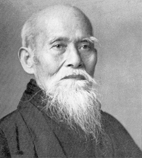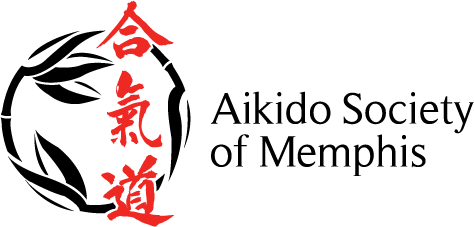About Aikido
 The Japanese word Aikido is written with three characters which translate as "the way of unity with the fundamental force of the universe".
The Japanese word Aikido is written with three characters which translate as "the way of unity with the fundamental force of the universe".
Aikido is one of the most contemporary of the traditional martial arts. Although based on other martial arts such as jujitsu and sword (kenjutsu) and spear (sojitsu) combative techniques and studied for self-defense, Aikido differs from other martial arts in that practitioners (Aikidoka) strive to defend themselves and others without causing injury to their attackers. Self-improvement, by enhancing self-awareness and focused concentration and improving mind/body integration are the ultimate goals of Aikido. Aikido is oftentimes referred to as moving meditation. The basic movements of Aikido are circular, or more precisely, spiral in nature; generally attacks are linear. The practitioner of Aikido seeks to harmonize or blend with the linear attack and convert it into a spherical motion. Rather than relying solely on strikes or kicks, the Aikidoka attempts to neutralize the attack with a multitude of wrist and arm locks, unbalancing throws and immobilizing shoulder pins and holds. The ideal is to redirect or neutralize the attack without unnecessary force or causing serious injury.
In keeping with the philosophy of self-improvement, Aikido is not a competitive martial art. Although both mentally and physically challenging and an effective exercise, Aikido is not a sport. Aikidoka train to improve themselves through self-control and without insult to others. Of the traditional martial arts, Aikido offers a very modern viewpoint, one with goals that challenge the Aikidoka toward greater self-knowledge, personal growth and social harmony.
The Practice of Aikido
The reasons to practice Aikido are varied. Practically, Aikido study can improve physical and mental conditioning and provide an effective self-defense. Since controlled throwing and falling are equally stressed - just getting up from the mat more than one hundred times during a class can itself be physically demanding. Improvements can be attained in endurance, coordination, balance, flexibility, and strength. Mental conditioning such as focused attention, sustained concentration, self-confidence, and self-discipline can be realized. As a self-defense Aikido provides a wide range of self-protective techniques. Gentleness and control are ideals, but nothing can be more devastating than a forceful throw to the ground or being held by an immobilizing and painful joint-lock. With an emphasis on blending and redirecting, Aikido provides a moral ethic of defending oneself without vengeance, malice or unnecessary subjugation. Both within and outside of the dojo, Aikido provides a metaphor for a life's path: be alert, stay in the moment, attempt to avoid confrontation and conflict, harmonize with unavoidable stressors, and maintain self-control under duress. To continually seek and maintain your center, or balance, is a proud goal to achieve through Aikido.
As Aikido does not depend exclusively on physical size or strength, it can be especially attractive to women, children and older people. People of all ages, shapes and sizes through accommodation can practice and improve their Aikido abilities well into old age.
Along with the study of self-defense with empty-hand techniques (taijutsu), one also learns to defend oneself against weapons. Through the use of the jo (walking stick), bokken (wooden sword), and tanto (wooden knife), the Aikidoka learns distance, timing and self-control in conjunction with the primary study with empty hand techniques.
Students of the Aikido Society of Memphis attend classes and accumulate practice hours toward testing eligibility. Progression through the ranks is determined through nationally standardized examinations which are held locally generally twice yearly. Within the United States Aikido Federation, there are six white-belt examination ranks called "kyu." These are followed by the black-belt grades called "dan" rankings (shodan, first dan; nidan, second dan; sandan, third dan, etc).
